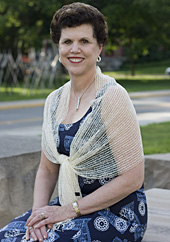AMES, Iowa -- The federal budget compromise for the 2011 fiscal year will include a $500 million cut to the Federal Pell Grant program, although the maximum award will still be $5,550 for the next academic year. The cut to the Pell program comes amid a new national report -- authored by researchers from three universities, including Iowa State University -- showing that recent increases in Pell Grant funding have produced both increased enrollment and students taking more credit hours at community colleges in recent years.
The report, titled "The Growing Impact of the New Pell Grant Funding: A profile of 205 Community Colleges in 25 States," was presented this week at the annual meeting of the Council for the Study of Community Colleges in New Orleans.
Linda Serra Hagedorn, a professor of educational leadership and policy studies (ELPS) and associate dean of the College of Human Sciences at ISU, was co-director of the project.
"Pell Grants are awarded on the basis of need," said Hagedorn, who is also president of the Association for the Study of Higher Education. "The fact that the number of awards increased so drastically speaks loudly that disadvantaged low-income students were stepping across the threshold of opportunity -- and doing so at the invitation of our President.
"Our country needs skilled American workers and the community college is the appropriate venue to attract low-income and displaced workers," she continued. "I fear that policymakers will learn too late that restricting access will only lead to increased dependence on foreign knowledge workers and a continuation of a depressed economy."
Stephen Katsinas, a director and professor in the Education Policy Center at the University of Alabama, directed the project, which was conducted under the auspices of the National Rural Scholars Panel of the Rural Community College Alliance. Joyce Lui, a second year Iowa State ELPS doctoral student, also collaborated with researchers from the University of Alabama and California State University Northridge on the research.
Data from from 205 community colleges in 25 states
The report summarized responses from 205 community colleges in 25 states to a survey conducted in summer 2010 through January 2011. There were complete responses from community colleges and technical colleges in nine states, including Iowa.
The research found that community college enrollment increased by more than 200,000 students from 2008-10 at the institutions that participated in the survey, while the total number of Pell Grants increased by 388,588 during those two academic years. During that time, full-time equivalent enrollment (students who took 12 credits hours per semester) saw a 14 percent increase, as compared with a 9 percent increase in total enrollment at the institutions in the sample. In the summer, full-time enrollment (FTE) grew by 15 percent, while total enrollment saw a 10 percent increase.
Researchers concluded in the report that expanded Pell grants appear to be enabling students to attend community colleges full-time -- particularly in the summer -- which could eventually lower the time-to-degree and improve college success rates.
"The data shows that Pell grants are providing greater access and more students are becoming full-time students," Lui said. "And if more students are becoming full-time students, then the idea is that it will be quicker for them to accomplish their goals -- whether it's a certificate, or transferring to a four-year institution like Iowa State. It's undeniable what the funding does to allow them to complete their goals."
The study also showed how Pell Grants are reducing the marginal costs of attending community colleges. While tuition, fees, books and supplies increased by $255 on average between 2008-10, the average Pell Award rose by an average of $596, or 5 percent, during the same period.
Rural community colleges see great Pell benefits
Lui also reports that rural community colleges -- like the ones found in Iowa -- saw their full-time enrollments almost double as a result of the expanded Pell Grant opportunities.
"A lot of the media rhetoric around community colleges has been centered around large, urban community colleges [30-50,000 students and multiple campuses]. But in the state of Iowa, the rural ones really do a lot to serve our students and our communities and they've benefitted from this Pell grant policy," Lui said.
The new report presents a comprehensive view of data from all 205 schools in the sample. Another report will be issued in several weeks highlighting the nine states that provided complete data.
Hagedorn and Katsinas have met with lawmakers on Capitol Hill
to share their research with them. Lui says they plan to
present this research to their peers at additional professional
conferences.
